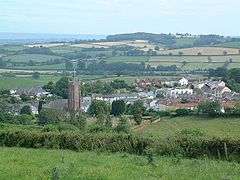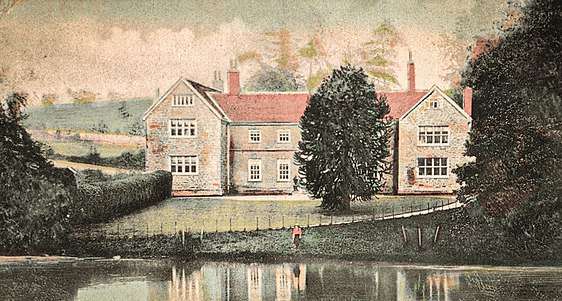Bradninch
Bradninch is a small town and former manor in Devon, England, lying about three miles south of Cullompton. Much of the surrounding farmland belongs to the Duchy of Cornwall. There is an electoral ward with the same name. At the 2011 Census the ward population was 2,041.[1]
| Bradninch | |
|---|---|
 Bradninch from Castle Hill, St Disen's Church is to the left | |
 Bradninch Location within Devon | |
| Population | 2,041 (2011 census) |
| OS grid reference | SS9903 |
| District | |
| Shire county | |
| Region | |
| Country | England |
| Sovereign state | United Kingdom |
In 2012, in research of 2,400 postcodes in England and Wales which took into account 60 separate factors of interest to young families, Bradninch was found to be the fifteenth most family friendly location in the country.[2]
The town is twinned with Landunvez in Brittany.
Toponymy
The place-name 'Bradninch' is first attested in the Domesday Book of 1086, where it appears as 'Bradenese'; the name is thought to mean 'broad oak'[3] or 'broad ash'.[4] Seventy-nine different spellings of the name of the town have been recorded.[5]
History
Anglo-Saxon
Bradninch dates back to before the 7th century and at some time there was almost certainly a Norman or Anglo-Saxon fortress on Castle Hill. There are no physical remains, and no known primary documentary references, but the likely site was surrounded by a number of 'castle' field names on the tithe map. It would have been unusual for Bradninch not to have had a castle given its status in the medieval period.
Norman
Bradninch was the caput of the feudal barony of Bradninch granted by William the Conqueror (1066–1087) to William Capra, who is listed in the Domesday Book of 1086 as holding this manor. The barony escheated to the crown and King Henry I (1100–1135) granted it to his illegitimate son William I de Tracy (d.circa 1136). He left one daughter and sole-heiress Grace de Tracy who married John de Sudeley,[6] They had two children: Ralph de Sudeley (d. 1192), the eldest, who became his father's heir, and Sir William II "de Tracy" (d. post 1172), who inherited his mother's barony of Bradninch and assumed her family name in lieu of his patronymic.[6] He married Hawise de Born and had a son William III de Tracy (d. pre-1194),[6] one of the four knights who assassinated Thomas Becket, Archbishop of Canterbury, in December 1170.
The value of Bradninch
Following the execution of King Charles I in 1649, an Act of Parliament was passed which allowed the sale of the feudal barony of Bradninch (or "honour of Bradninch") together with its caput, namely the manor of Bradninch, together with the borough of Bradninch, and on 24 March 1650 all were sold for the sum of £19,517 11 shillings 10 1/4 pence to Thomas Sanders and John Gorges as trustees for the new Commonwealth. The feudal barony and manor were returned to the Dukedom of Cornwall following the Restoration of the Monarchy in 1660[7] although the feudal element of the holding was effectively extinguished at about the same time by the Tenures Abolition Act 1660. Prince Charles, as the present Duke of Cornwall, remains the nominal lord of the manor of Bradninch, and the theoretical feudal baron of Bradninch, and continues to own much of the land within the parish. In July 2016 he visited Bradninch to inspect a new "affordable housing" development built there in partnership by the Duchy and the Guinness Trust.[8]
Later history
Bradninch lost its borough status in 1886 under the provisions of the Municipal Corporations Act.[9]
The town was largely destroyed in a fire in 1666 (the same year as the Great Fire of London).
Notable buildings
Notable buildings in the town include Bradninch Guildhall (on which the Bradninch Eagle is depicted), The Castle Pub, the manor house, Earlsland House, Comfort House, and the parish church.

St Disen's Church
The 15th-century church is dedicated to St Disen, a unique dedication in the British Isles, who is considered to have been an Irish missionary saint.[10] Previously this church was dedicated to St Denis or St Dionysius, and some confusion has arisen with some believing the attribution to St Disen to have been a romantic invention of one of the 19th-century vicars of the parish, Rev. Mr. Croslegh.[11] The church possesses a finely decorated screen; in the panels at the screen's base are nearly 50 paintings of saints and biblical scenes. Another screen in the church is simpler, with panels of various saints, including an unusual one of St Francis of Assisi receiving the stigmata.
Bradninch Manor House

The surviving grade I listed[12] manor house is situated on the north side of Parsonage Lane, to the immediate east of the village. It was built in 1553[13] by Peter Sainthill (c.1524-1571), MP, Recorder of Bradninch and Deputy Steward to the Duke of Cornwall of the manor of Bradninch.[14] It was the scene of Peter's Banquet or The Cavalier in the Dumps, a Puritan satirical verse written circa 1645,[15] describing a banquet held there during the Civil War for his soldiers by Captain Peter Sainthill (1593-1648), MP, grandson of the builder. One of the verses is as follows:
- Peter, their Captain, for to try
- If good King Charles they'd stand by,
- Prepared a Banquet at his hall,
- And there invited one and all
- To eat, and drink, and for to sing
- "God bless the cause! God bless the King!"
The present structure represents only half of the original "H-shaped" building.[16] During World War II it served as a home for evacuees from Duchy-owned properties in London. Immediately after the War, in the late 1940s it served as a boarding school for very young children.[17] Many of the original fittings of some of the 17th century rooms were removed illegally by the then owners in 1980,[18] but the magnificently decorated Job Room survives in its original Jacobean form, and is comparable to a similar room with internal porch at nearby Bradfield House, Uffculme.[19][20]
Political representation
In the 2010 UK General Election, the new constituency of Central Devon, which includes Bradninch, returned a Conservative Member of Parliament, Mel Stride.
Bradninch lies within the Cullompton Rural ward of Devon County Council and within the Bradninch ward of Mid Devon District Council.
Population
The 2012 population estimate for the town was 2,222.[21] The 2013 population estimate for the town was 2,366.[22] According to the Office for National Statistics Bradninch Ward had a population of 1,775 in April 2001.[23]
In 1887, according to John Bartholomew's Gazetteer of the British Isles, the population was 1,705
In 1851 the population was 1,834.[24]
Transport
The town used to be served by the Hele & Bradninch railway station at Hele, which is now closed. The nearest railway stations – all approximately 9 miles distant – are Tiverton Parkway which is on Great Western Railway's London Paddington to Penzance route and Pinhoe, Cranbrook and Whimple all of which are on South Western Railway's' London Waterloo to Exeter St Davids route.
The only regular public transport through the town is Stagecoach South West 1/1A/ “Culm Valley Connect" bus service that connects Bradninch with Exeter, Cullompton and Tiverton.
Books about Bradninch
The best known book about the town is by Charles Croslegh. He became vicar of Bradninch in 1897 and wrote a 360-page history of the town entitled "Bradninch, being a short historical sketch of the honor, the manor, the borough, and liberties, and the parish". Other books have been written about the history of Bradninch and Hele by Anthony Taylor and by Paddy Nash.[25]
Royal connections
The Bradninch 'eagle' seal – an eagle displayed sable on a shield argent – was given to the burgesses of the town in about 1120 by the illegitimate son of Henry 1, Arthur Reginald (Earl of Cornwall and Lord of Bradninch), when, by his letters patent, he incorporated the town and borough of Bradninch.[7]
In 1337 King Edward III bestowed the first English dukedom on his eldest son, also called Edward, (and later known as 'The Black Prince'), naming him the Duke of Cornwall and Baron of Bradninch. Since then, the Monarch's eldest son has been the Lord of the Manor of Bradninch. The Prince of Wales, Prince Charles, currently holds the title. Much of the farmland around the town still belongs to his Duchy of Cornwall estate.
Notoriety
Bradninch was one of the last towns in England to punish someone by placing them in stocks. On 2 November 1866 Cornelius Pippet, a cooper was convicted of drunkenness and placed in stocks for 6 hours.[26] The stocks are part of the town's historical memorabilia kept in the Guildhall.
It was in Bradninch, in 1702, that George Boone III, grandfather of the American pioneer Daniel Boone, joined the Religious Society of Friends (Quakers).[27] George Boone's son, Squire Boone, father of Daniel, left England for America in 1717.
References
- "Ward population 2011". Archived from the original on 3 March 2016. Retrieved 22 February 2015.
- "Family Friendly Hotspots 2012". Archived from the original on 4 October 2012. Retrieved 3 October 2012.
- Eilert Ekwall, Concise Oxford Dictionary of English Place-names, p. 58.
- Illustrations of Devon's History, R.R. Sellman, p23
- Croslegh, Charles – Bradninch, being a short historical sketch of the honor, the manor, the borough, and liberties, and the parish, p343
- Sanders, I.J., English Baronies, Oxford, 1960, p.20, Bradninch
- General Report to the King in Council from the Honorable Board of Commissioners on The Public Records: March 1831.
- Sunday Express newspaper, 18 July 2016
- "Municipal Corporations Act, 1883" (PDF).
- "St Disen's". Retrieved 5 October 2012.
- N. Orme, English Church Dedications, p. 53
- Listed building text
- Pevsner, p.201
- History of Parliament biography
- Quoted in full in Sainthill, Richard, Olla Podrida, pp.300-306; see full text on Wikisource s:Peter's Banquet, or, The Cavalier in the Dumps
- Pevsner, p.201
- http://bradninch-tc.gov.uk/index.php/bradninch-history/52-historic-buildings
- Listed building text
- Pevsner, Nikolaus & Cherry, Bridget, The Buildings of England: Devon, London, 2004, p.201
- See photo c.1949 of Job Room
- "PPSA population estimates of Mid Devon parishes". Archived from the original on 6 April 2012. Retrieved 3 October 2012.
- "PPSA population estimates of Mid Devon parishes". Archived from the original on 6 April 2012. Retrieved 3 October 2012.
- "Key Figures for 2001 Census". Office for National Statistics. 1 April 2001. Retrieved 17 January 2010.
- "Census statistics 1801–2001 Devon parishes B." Devon Libraries Local Studies Service. Archived from the original on 7 October 2012. Retrieved 27 April 2011.
- "Books on Hele and Bradninch". Retrieved 27 December 2012.
- Croslegh, Charles – Bradninch, being a short historical sketch of the honor, the manor, the borough, and liberties, and the parish.
- [Morgan, Robert. Boone: A Biography. Chapel Hill, N.C.: Algonquin Books of Chapel Hill, 2007; ISBN 978-1-56512-455-4]
External links
- The Bradninch Town Council website
- Entry in GENUKI (UK and Ireland genealogy), including description from the year 1850
- History of Bradninch